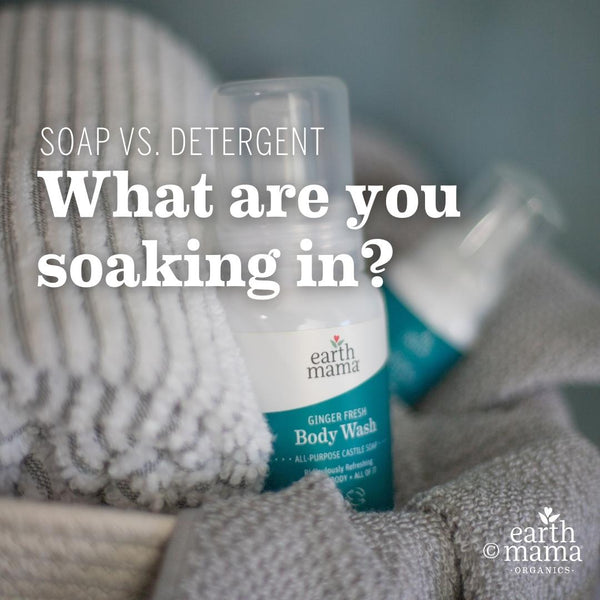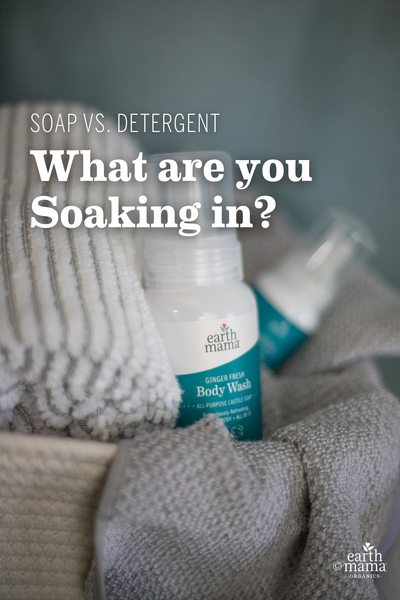Soap vs. Detergent: What are YOU Soaking in?

If you’re a parent you’d probably love a dime for every time you’ve prodded your kids to wash their hands, WITH soap! Since washing hands with pure soap is the best way to prevent spreading germs and disease, you’d think we’d all be clear about what that simple thing called “soap” is. But bar or liquid, your soap may not be so simple. And before you find out “you’re soaking in it” you may want to find out why!
True soap is pretty simple stuff. And it's very simply made. In fact, the very first soaps were made by boiling oils, blending them with ashes from the fire and, voila! Cave mamas could clean their pelts! Soap is the end product of blending pure fats or oils with an alkaline (like potassium or sodium hydroxide) solution. That's it. The oils are acids, the alkali is a base. Allow this acid/base solution to sit and stew for a while and the acids and bases neutralize each other. The oils are saponified, the scary-sounding stuff no longer exists, leaving a balanced, naturally sudsy soap, with a natural pH high enough that it doesn't require the addition of synthetic surfactants or preservatives.
Detergent, on the other hand, is a synthetic surfactant blend originally made to do a better job of cleaning laundry and dishes than natural soap. Detergents started being used in some personal care products like shampoos and body washes because the blend of synthetic chemicals is a less costly way to achieve lathering and cleaning properties.
What Is a Surfactant? Stay with us, it's simple. Natural soap is a surfactant, or surface acting agent. When you put a drop of water on a counter, it holds its shape. If you add a surfactant to it and reduce the surface tension, the water spreads out evenly and the droplet disappears. Surfactants help break surface tension, making water more effective at washing the dirt away. Soap acts as a surfactant – detergents contain synthetic surfactants.
Are All Synthetic Surfactants Toxic? No! But many of the synthetic surfactants found in detergent personal care products are under scrutiny for their toxicity to humans. These include common surfactants and emulsifiers like cocomidopropyl betaine, sodium laureth sulfate, cocamide DEA, TEA (Triethanolamine), and ethoxylated alcohols like ceteareth-12 alcohol, many of which are responsible for releasing carcinogenic formaldehyde and 1,4 Dioxane. On the other hand, decyl glucoside may sound scary, but is a gentle surfactant produced from a reaction between glucose (aka: sugar) from cornstarch and a fatty alcohol from coconuts.
How can you not be confused?! Sometimes something that sounds suspicious will be safe, and sometimes something that sounds natural will prove scary. A great resource is the Environmental Working Group’s Skin Deep database, where you can look up products by name, or look up individual ingredients.
What Else is in Detergents? Detergents usually also contain thickening agents like Polyethylene glycol (PEG) that make the detergent feel thick, even with the addition of up to 90% water. This group of agents has some of the highest toxicity ratings on the Skin Deep site, and carry serious concerns about organ system toxicity and carcinogenic cell mutation. And to help detergent shampoos "moisturize" many contain humectants or additives such as propylene glycol. Propylene glycol is a very common additive in personal care products and skin and respiratory irritant which can cause liver and kidney damage and is also found in paint, wallpaper removers and de-greasers. Yikes!
Does Soap or Detergent Need a Preservative? Because soap has a high enough pH to deter bacterial or mold growth, it does not need to have a preservative added. But detergent type shampoos and body washes do need to be preserved to keep them free of mold, bacteria and other goo. Common preservatives include methyl-, butyl-, ethyl- and proply- parabens, methylisothiazolinone, phenoxyethanol, diazolidinyl urea, Quaternium 15 and even formaldehyde, all of which have serious safety concerns.
Why is there a pesticide in my soap? Good question! Since washing hands with pure soap naturally kills germs and bacteria, there’s no need for antimicrobial pesticides.
Despite that fact, the antimicrobial agent Triclosan is found in liquid hand soaps, toys, teethers, cutting boards, garden hoses, dish gloves, changing tables and more. Triclosan has been found to disrupt hormones and may affect fetal growth and development and growing evidence links it to the rise of antibiotic-resistant bacteria. It also creates a toxic soup that is fatal to fish and sea creatures when it builds up in waterways.
"Fragrance" is no Bed of Roses. You'll often see the word "fragrance,” "fragrance oil,” or “parfum” in soaps and shampoos (and lotions, and oils). If an ingredient list includes the word "fragrance" it is not disclosing the source of the artificial fragrance. Avoid products that list the word "fragrance" in their ingredient panel because "fragrance" can contain carcinogenic phthalates and mask the addition of undisclosed and potentially toxic preservatives.
Read the Labels! Click on at least a few of the above links – or better yet, for your health and well being, read the labels of the personal care products you use on yourself, your babies and your whole family. Look up the brand, the product, or the ingredients on the Skin Deep database. If you see something that makes you worried, don’t use it. If you want to let the company know why you aren’t using it, write them a letter. That’s how change happens. The consumer is queen, and knowledge is power!
So that's the dirt on Soap vs. Detergent. We like to keep it simple, and save the detergent for the dirty diapers!

Save
